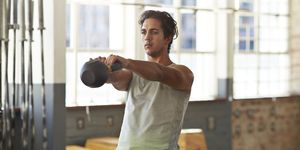Trainer, author, and fitness model Kirk Charles, NASM-CPT CES, knows that as you get older, life can get more complicated. But that shouldn’t prevent you from being on top of your game. He’ll help to answer the tough training questions that come with age so you too can be Fit Beyond 40.
If you’re over 50 years old, you’re currently battling the aging process to preserve your body’s strength and muscle. But you also need to fight to preserve something else too: Power. If strength is the ability to move a load, power is the ability to move that load fast— and it’s an important quality as we age, because it impacts our reflexes, our balance, and our ability to avoid falling.
It’s also something that you might not be training in your over-50 training regimen. There’s a good chance you’ve been taught to move weights with slow, controlled motions, focusing on muscles and time-under-tension—and yes, your body needs this. But you can’t train power with these slow motions. To train power, you need to let your body move fast.
One of the best ways to do that is the kettlebell swing. It’s a challenging, advanced move for older individuals, but it’s a move that you should gradually work to learn. All at once, it’ll help you blast calories, build critical glute, back, and core strength, and elevate your heart rate. And in addition to that, it gives you a chance to check that “explosive power” box in your training regimen.
Why? Because a kettlebell swing has to happen fast. Every swing rep challenges your glutes and hamstrings to explosively contract, and in doing so, you’re teaching your body to generate the power it absolutely must learn to generate.
Kettlebell swings aren’t easy, though, so don’t go to the gym and do them right now. Learn to do Romanian deadlifts first, because those moves awaken your glutes and abs, which may be long-dormant if you’ve spent years working a desk job.
Once you have that down, and can do 3 sets of 10 to 12 reps with a challenging weight, grab a kettlebell that’s a third of that weight and work to learn the swing.

To set up for the swing, stand with your feet slightly wider than shoulder-width apart, the kettlebell about two feet in front of you. Push your butt back and bend at the waist, lowering your torso and extending your arms so you can grab the bell. Grab it by the horns, tip it to your body, grip it tightly, and turn the pits of your elbows forward.
Tighten your abs (and never lose this tightness), then explosively hike the bell backwards, like a football, letting it travel between your legs without relaxing your abs (never let your back round). Push your butt back as you do this. Then stand up explosively and squeeze your glutes. Don’t do anything else or think about anything else; the “power” your body creates as you stand and squeeze your glutes will drive your hips forward and accelerate the bell upwards. Your glutes (not your arms or your upper body) drive the entire motion.
Once the bell has elevated as high as it wants to go (you’re not swinging to a target; that’s not worth your time, or the wear and tear on your aging shoulders), let its momentum carry it backwards and between your legs again for another rep. Aim to keep your arms tight to your torso when it travels backwards, protecting your shoulders and back. Then explosively stand for another rep.
Gradually, you’ll learn to string together multiple reps, but it takes time. Don’t feel the need to learn the swing in one session; take several weeks to master it in stages, as the video above shows. Remember: This is an ultra-challenging movement that presents far more challenge than its unassuming name would indicate, especially if you’re new to the gym.
But over time, over the course of weeks, you’ll be able to progress. Start with single reps, to master the motion, then work up to 3 sets of 8 to 10 reps. On each rep focus on squeezing your glutes as you stand. And know that you’re developing total-body power, one of the most underrated secrets to your longevity, both in the gym, and beyond too.
Source: Read Full Article

